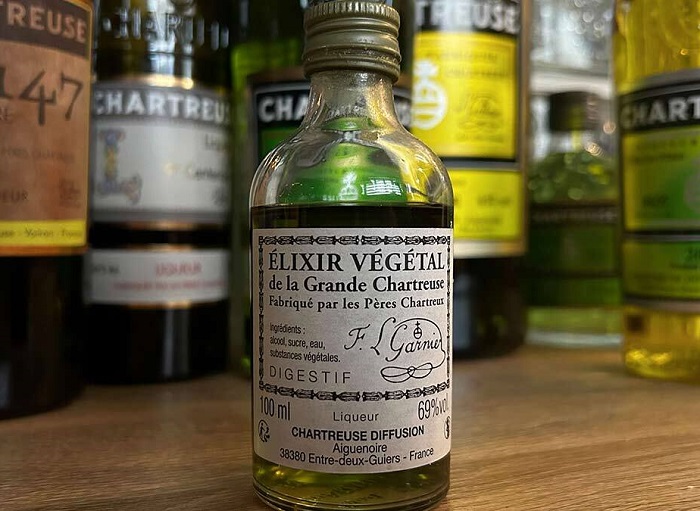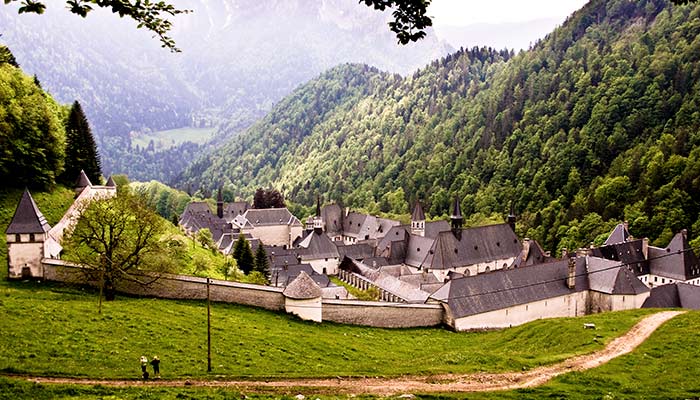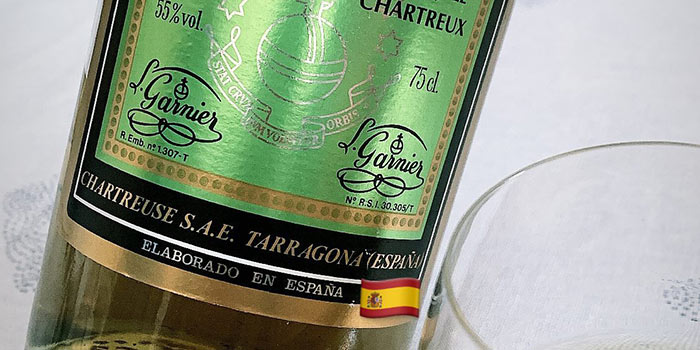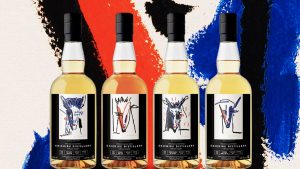
Are you familiar with the green and yellow liqueur from the Alps, which carries the name of the Order of monks who still produce it today? A history brimming with intrigue, a secret recipe, and some extremely rare vintages… Written by THE Chartreuse specialist in our iDealwine team, this article will immerse you in this captivating world, providing those who know little about this drink with the perfect introduction to the unique characteristics of these elixirs, their history and, we hope, ultimately leading you to tasting them!
THE HISTORY OF CHARTREUSE – HIGHLIGHTS
HOW THE RECIPE CAME TO BE
The story of the elixir is naturally associated with that of the Carthusian monks, which is, however, much older. This Order’s name derives from the mountains where the monks founded their monastery in 1084. Besides prayer, at that time these men of God were mainly involved in metal work.
It was in 1605 that the story of this liqueur unfolded. François-Annibal d’Estrées, then a military officer and future Marshal of France, approached the Carthusians to decipher an obscure manuscript about an elixir that required the use of a large number of plants. Unable to produce it himself, he donated the manuscript to the monks, already well versed in plants and authorised to craft and sell liqueurs. This 71% proof elixir was initially used for medicinal purposes and was improved by the monks over the years, in particular by Brother Jérôme (deceased in 1762), who devoted no less than 12 years of his life to it.

The Grande Chartreuse Monastery, home of the Carthusian monks
FROM ELIXIR TO CHARTREUSE LIQUEURS
In 1825, a different product emerged, leading to the creation of Green Chartreuse in 1840. According to the manuscripts of the time, it was developed to ‘conserve the virtues of the elixir without appearing to do so’. This marked the transition from medicinal elixir to a liqueur that was no longer consumed solely for its therapeutic properties. Yellow Chartreuse, produced around the same period, was a great success. At 48%, and later 43% proof, it was milder than its green counterpart, appealing to the consumers of the time. In keeping with the trend of the time, 70% of the production was dedicated to yellow liqueur.
EXPULSION IN 1903 – MIGRATION TO TARRAGONA
Over the centuries, the Carthusian monks suffered their share of disasters, both natural (avalanches, fires, landslides) and inflicted by man. The French Revolution triggered expulsions and looting of Carthusian monasteries, along with the persecution of monks, in some cases culminating in their execution.
The early 20th century was hardly any brighter. It was in a political climate of anti-clericalism that the expulsion of the monks of the Grande Chartreuse Monastery was ordered in 1903, along with the seizure of the property of the Fourvoirie distillery, where the different Chartreuses were distilled.
The expulsion was carried out despite the presence of a crowd of several thousand protesters. Military troops themselves reluctantly complied with the order, and a captain and commander of the French Dragoons involved in the operation even resigned following what the commander described as ‘a bandit’s job’.
A new owner was appointed to distil the Chartreuse… but the secret recipe had gone with the monks. The quality of the liqueurs produced by the new owner was clearly inferior to that distilled by the original producers, and sales proved difficult. At the time, a rival liqueur was being talked about… it was even rumoured to be the ‘real’ Chartreuse liqueur. The Carthusian monks, expelled in 1903, had sought refuge in Tarragona, in north-eastern Spain, where they were supplied with eaux-de-vie by the Muller family, supporters from the Champagne region, for some time. They were also helped by the Tarragona City Council, which had established a distillery in the city as early as 1902. And so production started in 1903. A series of media and legal battles ensued to prove that this Chartreuse was indeed the real deal…

BACK TO FRANCE, TARRAGONA/MARSEILLE
Carthusian monks first returned to France via Marseille where a distillery was opened in 1920 to operate alongside the Tarragona facility (which was in production until 1989). Its primary purpose was to overcome difficulties in exporting Chartreuse to France from Spain. This distillery was in use until 1929.
HOMECOMING
The Compagnie Fermière de la Grande Chartreuse, which had taken over from the Carthusian monks following their expulsion, faced increasing hardship from 1913 with the introduction of a ban on export sales of its liqueurs. Indeed, overseas courts frowned upon the fact that this liqueur derived from property plundered from the Carthusian monks. This contributed to the gradual collapse of the company, which went bankrupt in 1929. That same year, the Carthusian monks relocated their distillation equipment from Marseille to Fourvoirie. Business resumed in 1932 and the Carthusian monks returned to the Grande Chartreuse Monastery in 1940. Back to where it all started!
PRESENT DAY DISTILLERIES
In France, the venture was pursued in Fourvoirie until a devastating landslide in 1935. It was decided to produce the elixir from a distillery in Voiron until 2018. Nowadays, the Fathers produce the Chartreuses in Aiguenoire, at the foot of the Chartreuse Mountains. The Chartreuse Diffusion company was established in 1970 to oversee the packaging, advertising and sales of the Chartreuses. The Carthusian monks are still at the head of the distilleries and continue to guard the secret to the mysterious recipes.
THE CUVÉES
The liqueurs are produced with white alcohol from grapes (marc). While 130 plants are known to be associated with their composition, the mystery remains intact as to how much each one contributes, the recipe being secretly guarded by the monks. However, we know that to best extract the aromas and colours of these plants, some must undergo a process of infusion (in water) or maceration (in alcohol). The liqueurs are then aged in ‘foudre’ (large wooden tuns), or in demi-muids (600-litre barrels) for the more exceptional vintages.
TRADITIONAL LIQUEURS
A part of the history of Chartreuse since its beginnings
- Green and Yellow Chartreuse (since 1840)
- Elixir (since 1605)
SPECIAL CUVÉES
Special yet relatively accessible cuvées, offering a different tasting experience.
- Chartreuse Meilleurs Ouvriers de France Liqueur (since 2008)
- Elixir Liqueur – 1605 (since 2005)
- Liqueur of the 9th Centenary (since 1984)
- ‘Foudre 147’ Liqueur (since 2019)
For more information about these special cuvées and traditional liqueurs, visit the Chartreuse official website.
EXCEPTIONAL CUVÉES
Produced in limited quantities – and very limited quantities in the case of ‘Une Chartreuse’ – they undergo significant ageing.
- Chartreuse VEP Green and Yellow (VEP – Vieillissement Exceptionnellement Prolongé in French means Exceptionally Prolonged Ageing) (since 1963)
- Queen of Liqueurs (since 2010)
- Une Chartreuse Green and Yellow (since 2015)
COMMEMORATIVE CUVÉES
These cuvées pay tribute to the history of Chartreuse, like the cuvée ‘Marseille’ which, 100 years on, commemorates the distillery established in 1921 in the city of Marseille. They sometimes verge on the surreal, like the Tarragona cuvée of the century, which is a blend of ten vintages of Yellow Chartreuse from Tarragona (1906, 1910, 1920, 1930, 1948, 1951, 1961, 1967, 1973 and 1980).
- Santa Tecla Green and Yellow Chartreuse (since 2000)
- Episcopal Chartreuse of the 3rd Millennium (2000 only)
- Chartreuse Marseille (2021 only).
- Tarragona of the Century (2007 only)
… and many more!

CHARTREUSE CHARACTERISTICS AND HOW TO TASTE IT
The elixir, now 69% proof, has traditionally been used for medicinal purposes, although it is now used in bitter cocktails. Meanwhile, the liqueur is used in a number of ways. Before discussing its tasting, however, we should first consider another aspect of this liqueur, namely its ageing.
THE AGEING OF CHARTREUSES
Cask ageing undeniably has an influence on the Chartreuse, as evidenced by the differences with the VEP cuvées, which are subjected to prolonged ageing.
What’s more surprising is that the liqueurs also evolve once bottled. This shouldn’t come as a surprise to wine enthusiasts, but it makes these cuvées quite unique compared to other spirits, where the impact of bottle ageing is often controversial (with the exception of the Chinese spirit Baiju). As a result, the aromatic profile of a Chartreuse aged for several decades will be markedly transformed. Depending on when the spirit is opened, one plant or spice may come to the fore, rather than another. And the impact doesn’t end with the aroma: a real ‘patina’ develops on old Chartreuse, the texture becomes silkier and the alcohol, better integrated, is less noticeable with age.
In short, whether in the bottle or in the cask, ageing has a profound impact on the Chartreuse and makes for a unique tasting experience.
TASTING CHARTREUSES
To enjoy Chartreuse liqueurs, we recommend that you consume them (in moderation):
- In a tulip glass or a Cognac glass (note that ice cubes can break the structure of the liqueur).
- For cooking, in dishes. Chefs in the Rhône-Alpes region all constantly innovate to use the liqueur in sweet and savoury dishes.
- In a cocktail. Even the least experienced mixologist knows the potential of Chartreuse in cocktails. A cocktail bar dedicated to Chartreuse has actually been set up in the old Voiron distillery itself, which doubles as a tourist attraction.
OUR COCKTAIL RECIPE: THE CHARTREUSE MULE
As a true connoisseur of the products of this famous monastery, the author of this article also shares his recipe (which is less secret than those for the Chartreuse cuvées) for an incredibly simple yet delightful cocktail: the Chartreuse Mule.
Ingredients
Green Chartreuse (5 cl)
Ginger beer (15 cl)
Juice of half a lime
Mix and serve!
The growing popularity of the classic Moscow Mule (made with vodka) has established it as a rival to the Spritz in the most popular cocktail category. However, it is a fact that the alcohol (vodka) in this cocktail is merely a showpiece (which is sometimes just as well…). It’s a completely different story when you replace the vodka with Chartreuse. The aromatic intensity of the Chartreuse matches that of the Ginger beer, a sparkling soft drink with a strong ginger flavour. The balance is struck, the ginger appears and gives way to lingering herbal aromas. A real treat.

A Chartreuse granita to enjoy at the cocktail bar in the Chartreuse cellars
INCREASING DEMAND AND STABLE SUPPLY?
While Chartreuse suffered a slight decline in popularity in the 1970s and 1980s, it has since regained considerable popularity. This is probably due to its increasing use in cocktails, rising demand from other continents and its appearance in ‘pop culture’ through some renowned directors and artists. However, the supply is set to remain stable, at least that’s what Chartreuse Diffusion communicated in early 2023.
The company put forward a number of reasons for this, including the need to maintain quality, to avoid overburdening the monks, who need time to pray, and the refusal of ‘infinite growth’. While the firm stresses that it favours local and regional economies in France, a number of wine merchants, e-retailers and concerned restaurateurs are seeing a reduction in their allocations. Let’s stay positive, though: Chartreuse, with its 400 years of history, is still on our shelves and auction sites such as finespirits.auction, offering the chance to acquire old vintages or rare bottles for a timeless tasting experience.
The historical sections of this article were compiled with the help of the following sources:
– Chartreuse La liqueur, Chartreuse Diffusion
– Guide de l’amateur de chartreuse, Michel Steinmetz, Glénat



